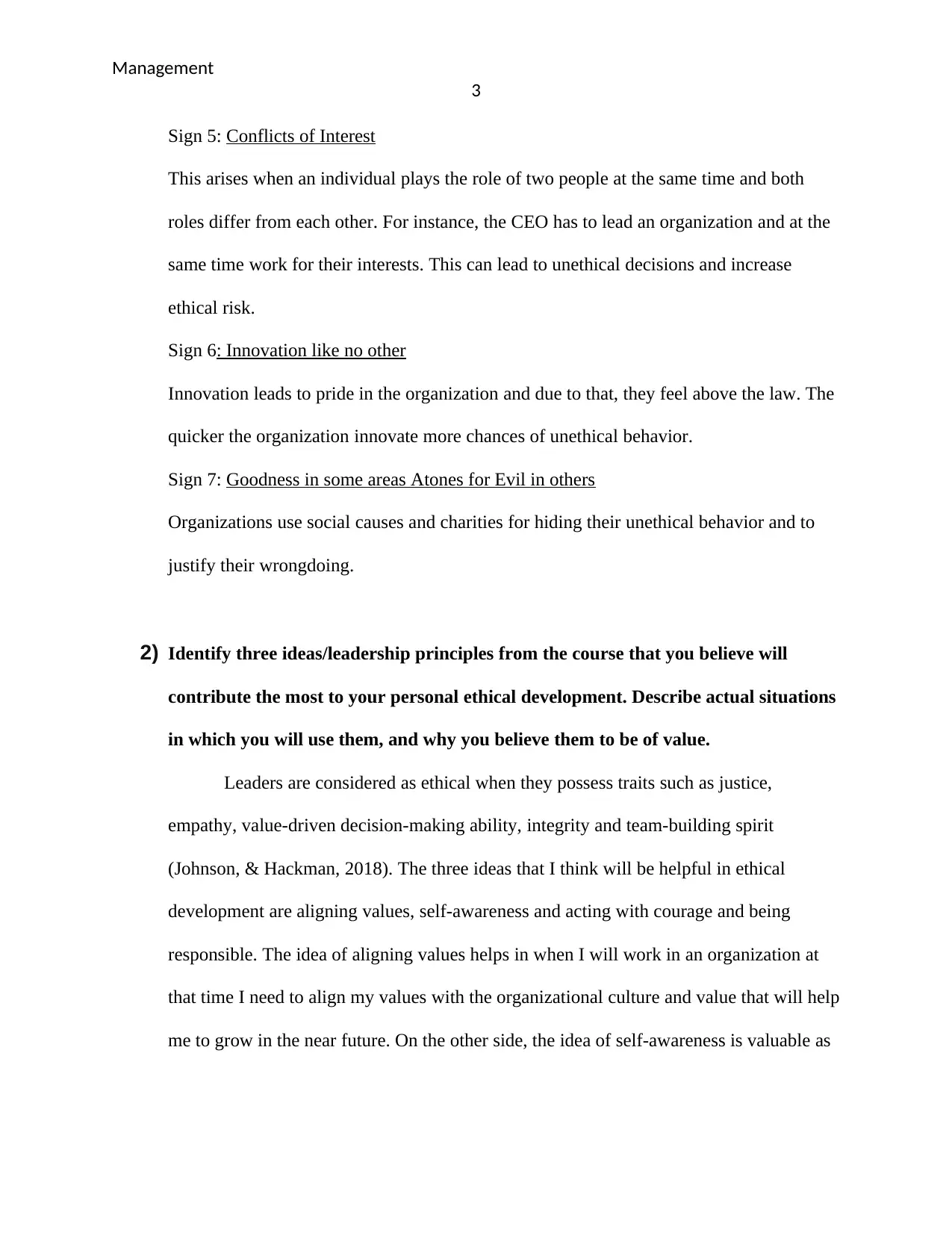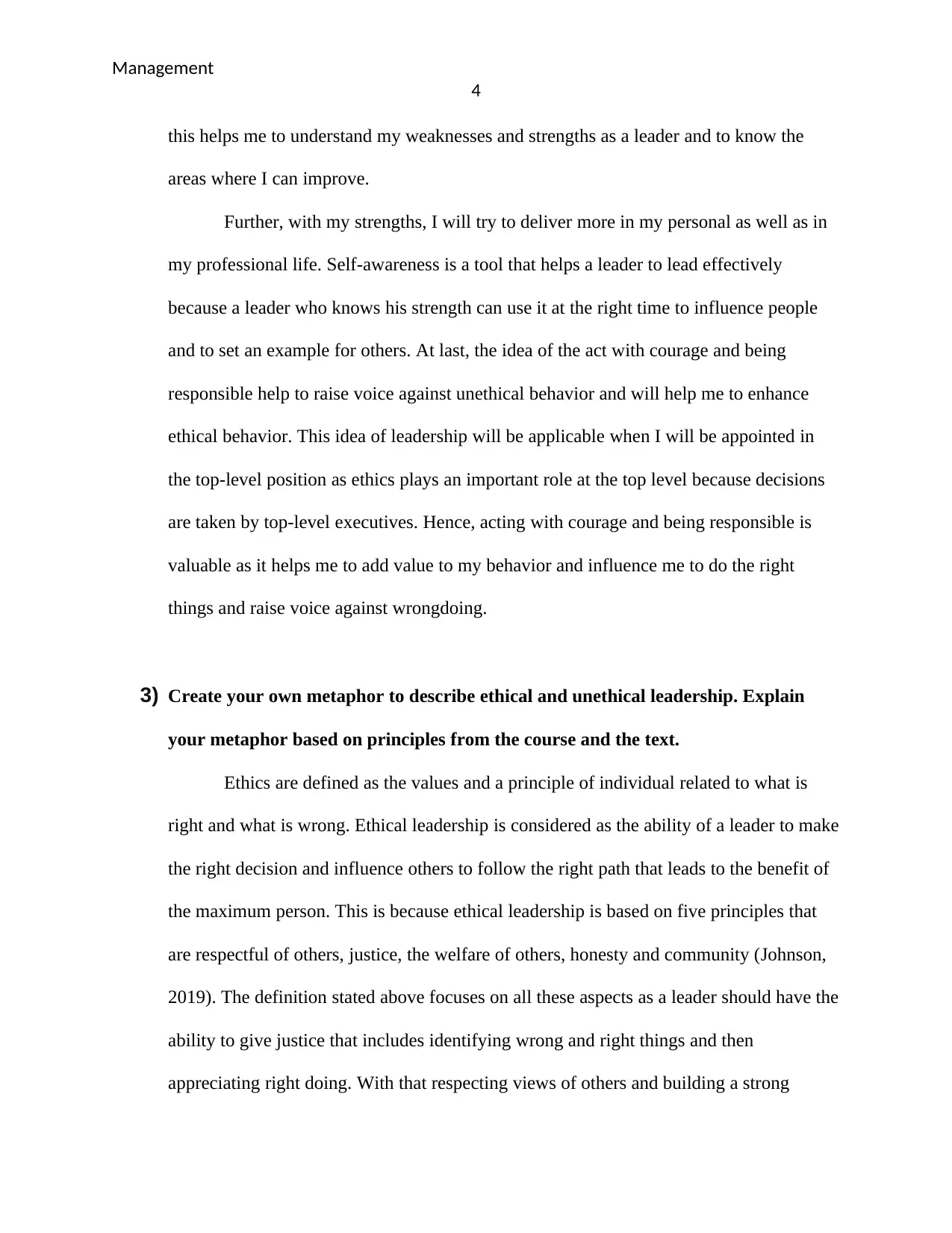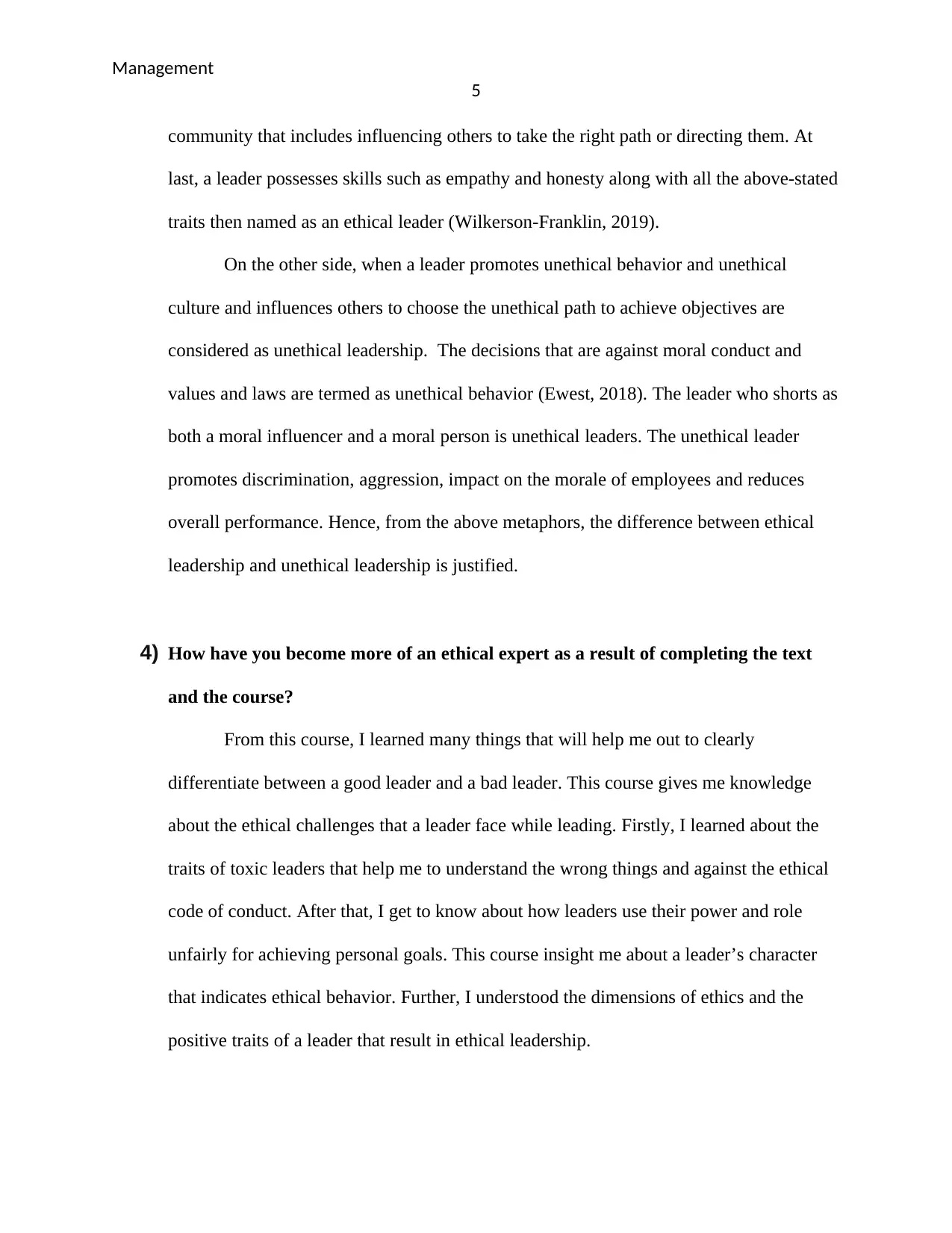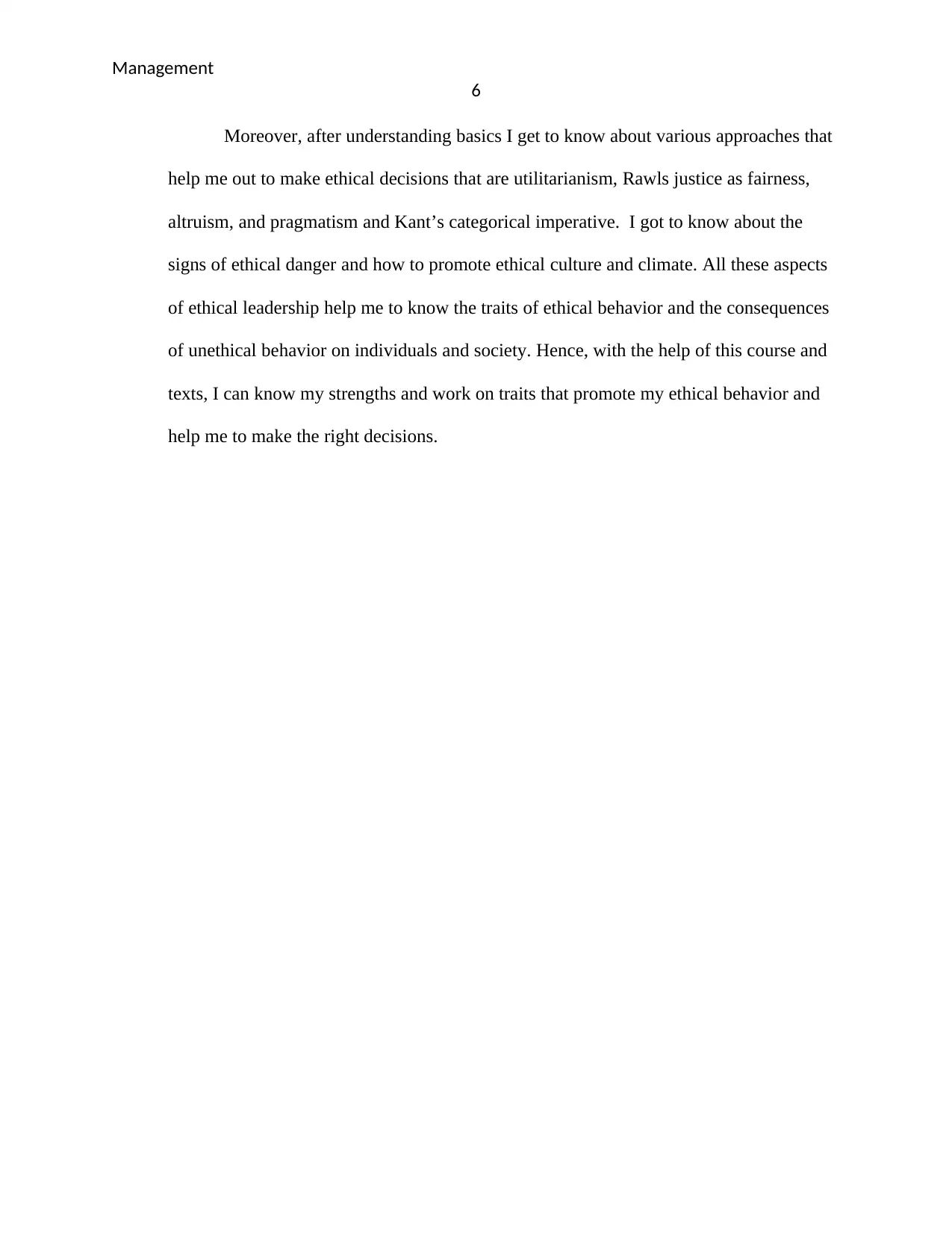University Assignment: Ethical Challenges in Leadership Analysis
VerifiedAdded on 2022/09/14
|7
|1391
|19
Homework Assignment
AI Summary
This assignment explores ethical challenges in leadership, addressing key concepts such as the signs of ethical collapse within an organization, as identified by Marianne Jennings. It delves into leadership principles that contribute to personal ethical development, including aligning values, self-awareness, and acting with courage and responsibility, providing real-world scenarios for their application. The assignment also tasks the student to create a metaphor to distinguish between ethical and unethical leadership, grounded in course principles. Furthermore, it reflects on the student's enhanced understanding of ethical leadership gained through the course, highlighting the ability to differentiate between good and bad leadership, recognize ethical challenges, and make informed ethical decisions using various approaches such as utilitarianism and Kant's categorical imperative, and their ability to identify signs of ethical danger.

RUNNING HEAD: MANAGEMENT
1
Ethical Challenges in Leadership
1
Ethical Challenges in Leadership
Paraphrase This Document
Need a fresh take? Get an instant paraphrase of this document with our AI Paraphraser

Management
2
1) Identify the seven signs that an organization is in danger of ethical collapse.
Marianne Jennings identified seven signs that indicate whether an organization is
in ethical danger or not (Johnson, 2019).
Sign 1: Pressure to achieve numbers
The first sign of ethical danger is meeting the targets or quantifiable goals. As
organization manipulate numbers such as overstate sales, showed fewer expenses and bad
loans in order to strengthen its position in the market
Sign 2: Silence and Fear
A culture of silence and fear can easily lead to ethical problems. For instance; if people
feel any misbehavior, the main decision-makers might be unsympathetic about their
concerns (Johnson, 2019). With that employees troubled to speak out their views and due
to that fear that they will be fired or demoted
Sign 3: Young ‘uns, and a bigger than life CEO
Some CEOs are icons who are adored by the media and the community and in order to be
successful, these CEOs surround themselves by young and loyal supporters but
inexperienced. Due to that, they follow leader unethical decisions if an enthusiastic and
dynamic CEO is leading them.
Sign 4: A weak board
A weak board also leads to ethical risk as they might have inexperienced members,
family members and friends of the CEO. All this leads to failure of meetings and
unethical behavior (Johnson, 2019).
2
1) Identify the seven signs that an organization is in danger of ethical collapse.
Marianne Jennings identified seven signs that indicate whether an organization is
in ethical danger or not (Johnson, 2019).
Sign 1: Pressure to achieve numbers
The first sign of ethical danger is meeting the targets or quantifiable goals. As
organization manipulate numbers such as overstate sales, showed fewer expenses and bad
loans in order to strengthen its position in the market
Sign 2: Silence and Fear
A culture of silence and fear can easily lead to ethical problems. For instance; if people
feel any misbehavior, the main decision-makers might be unsympathetic about their
concerns (Johnson, 2019). With that employees troubled to speak out their views and due
to that fear that they will be fired or demoted
Sign 3: Young ‘uns, and a bigger than life CEO
Some CEOs are icons who are adored by the media and the community and in order to be
successful, these CEOs surround themselves by young and loyal supporters but
inexperienced. Due to that, they follow leader unethical decisions if an enthusiastic and
dynamic CEO is leading them.
Sign 4: A weak board
A weak board also leads to ethical risk as they might have inexperienced members,
family members and friends of the CEO. All this leads to failure of meetings and
unethical behavior (Johnson, 2019).

Management
3
Sign 5: Conflicts of Interest
This arises when an individual plays the role of two people at the same time and both
roles differ from each other. For instance, the CEO has to lead an organization and at the
same time work for their interests. This can lead to unethical decisions and increase
ethical risk.
Sign 6: Innovation like no other
Innovation leads to pride in the organization and due to that, they feel above the law. The
quicker the organization innovate more chances of unethical behavior.
Sign 7: Goodness in some areas Atones for Evil in others
Organizations use social causes and charities for hiding their unethical behavior and to
justify their wrongdoing.
2) Identify three ideas/leadership principles from the course that you believe will
contribute the most to your personal ethical development. Describe actual situations
in which you will use them, and why you believe them to be of value.
Leaders are considered as ethical when they possess traits such as justice,
empathy, value-driven decision-making ability, integrity and team-building spirit
(Johnson, & Hackman, 2018). The three ideas that I think will be helpful in ethical
development are aligning values, self-awareness and acting with courage and being
responsible. The idea of aligning values helps in when I will work in an organization at
that time I need to align my values with the organizational culture and value that will help
me to grow in the near future. On the other side, the idea of self-awareness is valuable as
3
Sign 5: Conflicts of Interest
This arises when an individual plays the role of two people at the same time and both
roles differ from each other. For instance, the CEO has to lead an organization and at the
same time work for their interests. This can lead to unethical decisions and increase
ethical risk.
Sign 6: Innovation like no other
Innovation leads to pride in the organization and due to that, they feel above the law. The
quicker the organization innovate more chances of unethical behavior.
Sign 7: Goodness in some areas Atones for Evil in others
Organizations use social causes and charities for hiding their unethical behavior and to
justify their wrongdoing.
2) Identify three ideas/leadership principles from the course that you believe will
contribute the most to your personal ethical development. Describe actual situations
in which you will use them, and why you believe them to be of value.
Leaders are considered as ethical when they possess traits such as justice,
empathy, value-driven decision-making ability, integrity and team-building spirit
(Johnson, & Hackman, 2018). The three ideas that I think will be helpful in ethical
development are aligning values, self-awareness and acting with courage and being
responsible. The idea of aligning values helps in when I will work in an organization at
that time I need to align my values with the organizational culture and value that will help
me to grow in the near future. On the other side, the idea of self-awareness is valuable as
⊘ This is a preview!⊘
Do you want full access?
Subscribe today to unlock all pages.

Trusted by 1+ million students worldwide

Management
4
this helps me to understand my weaknesses and strengths as a leader and to know the
areas where I can improve.
Further, with my strengths, I will try to deliver more in my personal as well as in
my professional life. Self-awareness is a tool that helps a leader to lead effectively
because a leader who knows his strength can use it at the right time to influence people
and to set an example for others. At last, the idea of the act with courage and being
responsible help to raise voice against unethical behavior and will help me to enhance
ethical behavior. This idea of leadership will be applicable when I will be appointed in
the top-level position as ethics plays an important role at the top level because decisions
are taken by top-level executives. Hence, acting with courage and being responsible is
valuable as it helps me to add value to my behavior and influence me to do the right
things and raise voice against wrongdoing.
3) Create your own metaphor to describe ethical and unethical leadership. Explain
your metaphor based on principles from the course and the text.
Ethics are defined as the values and a principle of individual related to what is
right and what is wrong. Ethical leadership is considered as the ability of a leader to make
the right decision and influence others to follow the right path that leads to the benefit of
the maximum person. This is because ethical leadership is based on five principles that
are respectful of others, justice, the welfare of others, honesty and community (Johnson,
2019). The definition stated above focuses on all these aspects as a leader should have the
ability to give justice that includes identifying wrong and right things and then
appreciating right doing. With that respecting views of others and building a strong
4
this helps me to understand my weaknesses and strengths as a leader and to know the
areas where I can improve.
Further, with my strengths, I will try to deliver more in my personal as well as in
my professional life. Self-awareness is a tool that helps a leader to lead effectively
because a leader who knows his strength can use it at the right time to influence people
and to set an example for others. At last, the idea of the act with courage and being
responsible help to raise voice against unethical behavior and will help me to enhance
ethical behavior. This idea of leadership will be applicable when I will be appointed in
the top-level position as ethics plays an important role at the top level because decisions
are taken by top-level executives. Hence, acting with courage and being responsible is
valuable as it helps me to add value to my behavior and influence me to do the right
things and raise voice against wrongdoing.
3) Create your own metaphor to describe ethical and unethical leadership. Explain
your metaphor based on principles from the course and the text.
Ethics are defined as the values and a principle of individual related to what is
right and what is wrong. Ethical leadership is considered as the ability of a leader to make
the right decision and influence others to follow the right path that leads to the benefit of
the maximum person. This is because ethical leadership is based on five principles that
are respectful of others, justice, the welfare of others, honesty and community (Johnson,
2019). The definition stated above focuses on all these aspects as a leader should have the
ability to give justice that includes identifying wrong and right things and then
appreciating right doing. With that respecting views of others and building a strong
Paraphrase This Document
Need a fresh take? Get an instant paraphrase of this document with our AI Paraphraser

Management
5
community that includes influencing others to take the right path or directing them. At
last, a leader possesses skills such as empathy and honesty along with all the above-stated
traits then named as an ethical leader (Wilkerson-Franklin, 2019).
On the other side, when a leader promotes unethical behavior and unethical
culture and influences others to choose the unethical path to achieve objectives are
considered as unethical leadership. The decisions that are against moral conduct and
values and laws are termed as unethical behavior (Ewest, 2018). The leader who shorts as
both a moral influencer and a moral person is unethical leaders. The unethical leader
promotes discrimination, aggression, impact on the morale of employees and reduces
overall performance. Hence, from the above metaphors, the difference between ethical
leadership and unethical leadership is justified.
4) How have you become more of an ethical expert as a result of completing the text
and the course?
From this course, I learned many things that will help me out to clearly
differentiate between a good leader and a bad leader. This course gives me knowledge
about the ethical challenges that a leader face while leading. Firstly, I learned about the
traits of toxic leaders that help me to understand the wrong things and against the ethical
code of conduct. After that, I get to know about how leaders use their power and role
unfairly for achieving personal goals. This course insight me about a leader’s character
that indicates ethical behavior. Further, I understood the dimensions of ethics and the
positive traits of a leader that result in ethical leadership.
5
community that includes influencing others to take the right path or directing them. At
last, a leader possesses skills such as empathy and honesty along with all the above-stated
traits then named as an ethical leader (Wilkerson-Franklin, 2019).
On the other side, when a leader promotes unethical behavior and unethical
culture and influences others to choose the unethical path to achieve objectives are
considered as unethical leadership. The decisions that are against moral conduct and
values and laws are termed as unethical behavior (Ewest, 2018). The leader who shorts as
both a moral influencer and a moral person is unethical leaders. The unethical leader
promotes discrimination, aggression, impact on the morale of employees and reduces
overall performance. Hence, from the above metaphors, the difference between ethical
leadership and unethical leadership is justified.
4) How have you become more of an ethical expert as a result of completing the text
and the course?
From this course, I learned many things that will help me out to clearly
differentiate between a good leader and a bad leader. This course gives me knowledge
about the ethical challenges that a leader face while leading. Firstly, I learned about the
traits of toxic leaders that help me to understand the wrong things and against the ethical
code of conduct. After that, I get to know about how leaders use their power and role
unfairly for achieving personal goals. This course insight me about a leader’s character
that indicates ethical behavior. Further, I understood the dimensions of ethics and the
positive traits of a leader that result in ethical leadership.

Management
6
Moreover, after understanding basics I get to know about various approaches that
help me out to make ethical decisions that are utilitarianism, Rawls justice as fairness,
altruism, and pragmatism and Kant’s categorical imperative. I got to know about the
signs of ethical danger and how to promote ethical culture and climate. All these aspects
of ethical leadership help me to know the traits of ethical behavior and the consequences
of unethical behavior on individuals and society. Hence, with the help of this course and
texts, I can know my strengths and work on traits that promote my ethical behavior and
help me to make the right decisions.
6
Moreover, after understanding basics I get to know about various approaches that
help me out to make ethical decisions that are utilitarianism, Rawls justice as fairness,
altruism, and pragmatism and Kant’s categorical imperative. I got to know about the
signs of ethical danger and how to promote ethical culture and climate. All these aspects
of ethical leadership help me to know the traits of ethical behavior and the consequences
of unethical behavior on individuals and society. Hence, with the help of this course and
texts, I can know my strengths and work on traits that promote my ethical behavior and
help me to make the right decisions.
⊘ This is a preview!⊘
Do you want full access?
Subscribe today to unlock all pages.

Trusted by 1+ million students worldwide

Management
7
References
Ewest, T. (2018). The Challenges Within Ethical Leadership Theories. In Prosocial
Leadership (pp. 23-42). Palgrave Macmillan, New York.
Johnson, C. E. (2019). Meeting the ethical challenges of leadership: Casting light or shadow.
SAGE Publications, Incorporated.
Johnson, C. E., & Hackman, M. Z. (2018). Leadership: A communication perspective. Waveland
Press.
Wilkerson-Franklin, T. (2019). Meeting the ethical challenges of leadership, casting light or
shadow. Community Development, 50(1), 111-112.
7
References
Ewest, T. (2018). The Challenges Within Ethical Leadership Theories. In Prosocial
Leadership (pp. 23-42). Palgrave Macmillan, New York.
Johnson, C. E. (2019). Meeting the ethical challenges of leadership: Casting light or shadow.
SAGE Publications, Incorporated.
Johnson, C. E., & Hackman, M. Z. (2018). Leadership: A communication perspective. Waveland
Press.
Wilkerson-Franklin, T. (2019). Meeting the ethical challenges of leadership, casting light or
shadow. Community Development, 50(1), 111-112.
1 out of 7
Your All-in-One AI-Powered Toolkit for Academic Success.
+13062052269
info@desklib.com
Available 24*7 on WhatsApp / Email
![[object Object]](/_next/static/media/star-bottom.7253800d.svg)
Unlock your academic potential
Copyright © 2020–2025 A2Z Services. All Rights Reserved. Developed and managed by ZUCOL.
